The craft of woodcarving has been used in Russia since ancient times.
True, only a few samples have survived to our time. This was due to their low cost and the fragility of the very material of which they are made. From the wood of the master and simple people made figurines of animals, birds, various amulets, which were passed on from generation to generation. The inhabitants of that time believed that the tree is the link between the sun and an ordinary person.
But very often wood products were of a purely practical nature or were cult objects that were used by almost the whole family.
According to some written sources that have survived to this day, we can judge the culture of the time when they were made. After all, the ancient Slavs, who inhabited the territory of the modern European part of Russia, were still engaged in the manufacture of these products. Since the manufacture of such items was mainly carried out by craftsmen, the tree acquired, as it were, a second life.
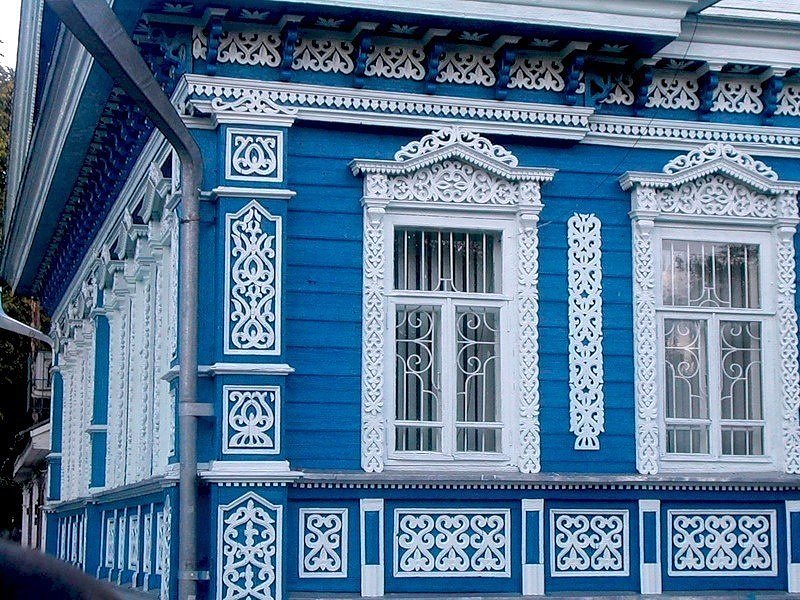
Wooden carvings were used to decorate pieces of furniture, dishes, toys and other products. Indeed, at that time, wood was a very popular material. Wood carving was widely used in wooden architecture of that time, giving us many monuments of architectural art. Wood craftsmen in Ancient Rus possessed great knowledge in this field of art, an excellent sense of beauty, rich imagination and a sense of beauty. All this allowed them to create real works of art and among wooden toys, and among the architectural buildings.
Artifacts found in Novgorod during archaeological excavations are weighty evidence. Of particular interest is a fragment of a wooden column, which belongs to modern scientists to the 11th century AD. It is decorated along its entire length with a pattern that does not repeat along its entire length.
By the way, such patterns prove the fact that the development of creativity was even earlier than this period by enough high level among the inhabitants of that era. Already by those objects that were found much later than their use, modern scientists can judge the development of the culture of that time. It was they who brought in the missing part that helped modern historians to recreate the general picture of the life of that era.
Wooden decoration can also be judged by how wooden buildings were decorated four hundred years ago. This is reflected in numerous chronicles of those years. They vividly and vividly tell about the life of the people who lived at that time, their way of life, both cultural and religious. These architectural monuments of that time and household items contributed a lot of information to the treasury of the history of our country.
common type of Russian. the architectural carving was flat carving. It is also called crenate, grooved, notched, trihedral-notched. All kinds of geometric patterns were cut out with an ax and a chisel on thick, hand-chipped boards, and the background and bulge on them are not opposed to each other. Ancient flat wood carving has had a definite impact on stone carving. Many plots of flat carving are associated with the ancients pagan beliefs Slavs and their magic spells. Such widespread motifs in folk patterns as circles, rosettes, stars, cruciform signs, as well as squares and rhombuses, served in ancient times as symbols of fire and sun and were supposed to protect the home.
If in the Stone Age and Eneolithic Birds, animals, the sun, etc. were realistically depicted, then by the 2nd millennium BC. they are already turning into symbolic figures: birds (ducks) - into zigzags, the sun with rays - into a circle, a wheel, etc.
These have already become approx. 4 thousand years ago, symbolic images of birds, animals, the sun, etc. survived to this day in the decoration of houses. At least from the Neolithic to the present day, Rus. folk art and architecture brought to us images of pagan amulets and bereginas.
In the Volga region, relief carving was widespread, which is often also called ship carving. Here, the rich pattern of the picture with high rounded edges already rises in relief above the background. The patterns were composed mainly of plant elements - from finger leaves, curls resembling antique acanthus, fruits, flowers, bunches of grapes, which were often complemented by images of fantastic creatures: sirens - half-women, half-fish, sirins - birds with a female head, lions, as well as classical motifs rosettes, medallions, squares, etc. Intricate carving with a raised relief and bizarre patterns of interweaving of grasses, animals and birds was already known in Ancient Russia. The rich carving of stone Vladimir churches of the 12th - 13th centuries, in all likelihood, reflected the techniques of wood carving that were common at that time. Columns of the 11th century are known. with relief carvings from Novgorod. In the XV - XVI centuries. such a carving was called Fryazhskaya, in the 17th century.
carving with a high relief is called figured or flem, the masters of the Moscow Armory were especially famous for it.
In the second half of the XIX century. in Russian In villages, flat and relief carving began to disappear everywhere, being replaced by saw-cut carving. With such a thread, the pattern is applied to the surface of the board not by gouging, but is sawn through with a jigsaw in a thin board, and then stuffed onto the platbands, frontal boards etc. Embossed and flat carvings are retained only as a finish and to complement jigsaw patterns. At first, sawn patterns were fairly simple, but by the end of the 19th century. complex compositions with plant and zoomorphic motifs are made from simple geometric shapes. Despite the simplification of the carving process, the cost of decoration sometimes amounted to a quarter of the value of the house, although usually the average peasant decorated the house only with carved platbands and a modest pattern along the pediment or cornice.
In Russian. coloring was also widely used in wooden architecture. US. it was used to decorate pediments, filing of roof overhangs, mezzanines, balconies, and shutters of platbands. In the Volga region, mainly window shutters, pediments and gates were painted. Drawings, simple in execution, were made in an extremely bright range of colors - blue, red, green, white and yellow. Usually carved decorations were painted, and often the entire building as a whole. This kept it from rotting. The coloring of architectural details never violates the structural plastic of a building, but only emphasizes its expressiveness.
The origins of wood carving and painting in Russia are very ancient and go back to art Eastern Slavs... The abundance of forests made wood the most affordable material, convenient in processing and use. They cut a hut out of wood, made a cradle and a toy for a child, a spinning wheel and a spindle for a woman, festive table- a bucket and salt lick, for riding - a sled and an arc. And all this is durable, comfortable, beautiful from pine and spruce, larch and birch, oak and maple.
True, only a few samples have survived to our time. This was due to their low cost and the fragility of the very material of which they are made. Craftsmen and ordinary people made figurines of animals, birds, various amulets from wood, which were passed on from generation to generation. The inhabitants of that time believed that the tree is the link between the sun and an ordinary person. 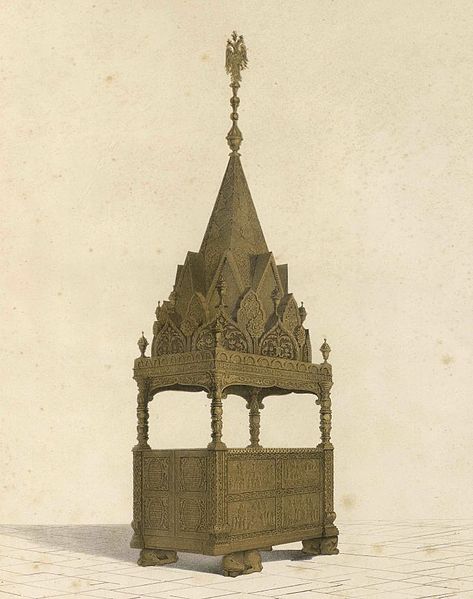
In Russia, woodcarving was called carving. The drawing is a sign, the words were also used: vysorochee, ornamental. Carved case in folk traditions... Carving on a flat surface in the form of braids and straight lines, teeth, Gorodets and Kyots, grooves, stars, poppies, fungi, gags, etc. One of the samples of this ancient carving - a royal place in the Assumption Cathedral.
At the end of the 15th century, the monk of the Trinity-Sergius Lavra, Ambrose, combined Eastern, Western and traditional Russian ornament in his works and had a great influence on the development of carving in the 15th-16th centuries.
Ancient images of herbal designs are in the Byzantine style. Not earlier than the 16th century, Fryazhina (Fryazh herbs) appeared - herbal decorations borrowed from Italy.
In the second half of the 17th century, German carving, figured, with Gothic motives appeared in Russia. In 1660, the royal dining room, designed by the German architect Deckenpin, was decorated with these carvings. New tools and German names and terms have appeared: gzimzumb, scherhebel, sharkheben, foundkhteble, etc. Cornices, gzimzy, shlengeri, krakshtyns (bracket), transoms, droplets, spring herbs, fruits, etc. appeared in carvings and furniture. Craftsmen began to make carvings according to German master's face books - that is, according to samples and drawings.
The rezis were painted with bright colors, sometimes covered with gold leaf.
But, very often wood products were of a purely practical nature or were cult objects that were used by almost the whole family.
Wood is an extremely versatile and beautiful material. Outwardly, the products made from it are simple, the forms are monolithic, the decorations are harmoniously connected with the whole object, do not violate its architectonics. Wood carving is conditional, and it is necessary to find a certain rhythm and combination of patterns so that the tree comes to life, attracts, radiates warmth. The sparseness or, conversely, the density of the laid pattern determines the artistic appearance of the entire product.
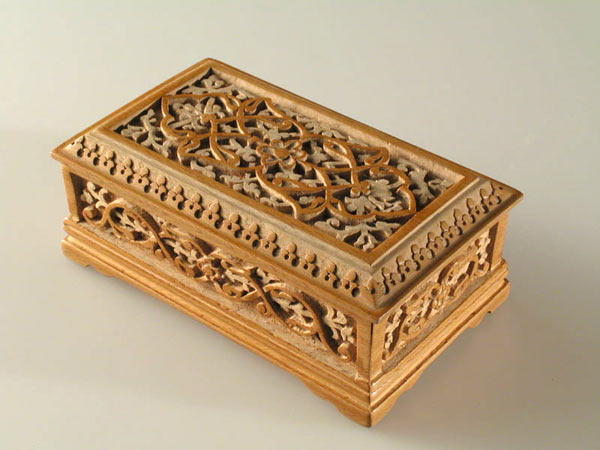
The origins of wood carving in Russia.
Life, dwellings in Russia were inextricably linked with a tree. At birth, the child was placed in a wooden cradle, given a wooden toy, the person remained, surrounded by a tree until old age, in a carved wooden rocking chair. Wood carving has become a part of the life and destiny of the Russian people. According to Slavic mythology, the world tree - the axis of the world - stands on the outskirts of the Universe (near Lukomorye), its top rests on the heavens, the roots reach the underworld. The gods descend and ascend along this tree, through it one can penetrate into other worlds. In the painting of Russian peasant houses, an indispensable element was the "tree of life", which served as a "symbol good wishes and a security sign. " Russian craftsmen carved out of wood everything necessary for life: furniture, utensils, etc. wood carving accompanies a person through life. In the era of Peter I, our carpenters surprised Dutch shipbuilders with their skill of carving, their ability to work accurately and quickly with wood. But all this could be done only by understanding the tree very well and feeling it as a living, animate material. Any piece of wood is unique, lives its own life. The author tries to feel the soul of a tree, to convey its energy to the space in his products, especially when working with an icon, adding as little as possible from himself. Wood inspires, and carvings fill our home with life-giving power.
The topic of "wood carving" is found in a large number of literature. The tradition of carving is very ancient. This is carved furniture and all sorts of carved little things like caskets, toys and jewelry- the list of wood carving applications is very large. Separately in this row is the church carving - iconostases, icon cases. Least of all are the very rare now carved icons. The current idea of the icon is associated only with painting. About the ancient Russian icon-painting tradition, in contrast to the carved one, a lot has been written, a huge number of printed reproductions of hand-painted icons. Little is known about the carved tradition. In the article "carving" (V. Dahl's Explanatory Dictionary of the Living Great Russian Language, vol. 4.): "Carving, or carving - ornamental decoration from the hand of wood, bone", "carver" (in Dal through "er") - "carving anything made of bone, horn, wood "," icon-painting carver "- cutting icons.
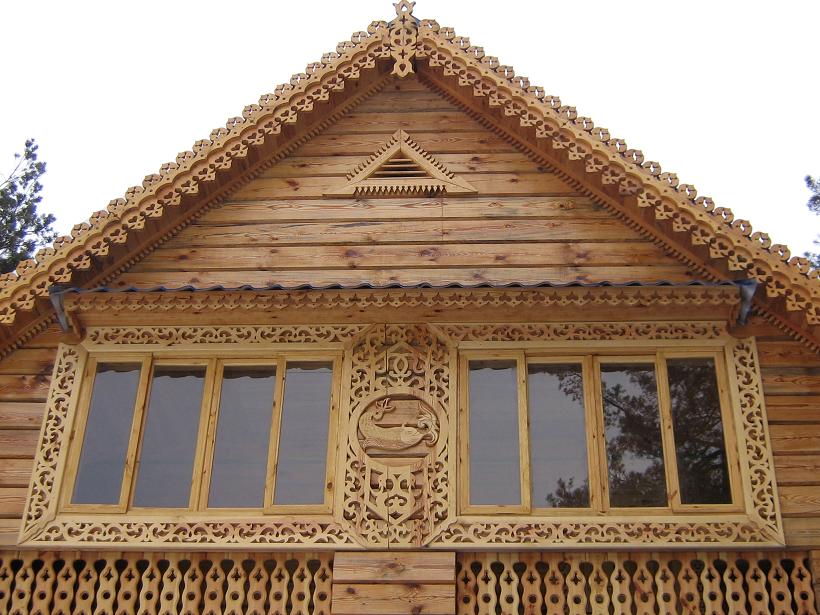 The nature itself and the traditions that have developed over the centuries prompted the carver and painter to form an object, a drawing of a pattern. True, in the world of folk images, not everything and not immediately becomes clear. So, circles, squares, shallow cuts of geometric carving, which are now perceived as a decorative pattern, in the past were endowed with meaning: a circle symbolized the sun, wavy lines - water, furrows - a field. Images of birds took an important place in folk art. The swan personified the water element, at the same time - spring, was considered a messenger of trouble and joy. Among animals, the horse was especially revered, which was a symbol of the sun. You can often see images of amulets that protected a house and a person from evil spirits. Lions, naiads, mermaids, unicorns, fabulous monsters are found in carvings and paintings on a variety of objects. Russian wooden dishes also includes the shape of this or that bird, but by the 18th-19th centuries the original meaning of such a rapprochement was lost and, as A.K. Chekalov correctly noted, “ancient symbolism lives mainly as a working principle of arrangement, as the most perfected, established for centuries reception of the organization of the material ".
The nature itself and the traditions that have developed over the centuries prompted the carver and painter to form an object, a drawing of a pattern. True, in the world of folk images, not everything and not immediately becomes clear. So, circles, squares, shallow cuts of geometric carving, which are now perceived as a decorative pattern, in the past were endowed with meaning: a circle symbolized the sun, wavy lines - water, furrows - a field. Images of birds took an important place in folk art. The swan personified the water element, at the same time - spring, was considered a messenger of trouble and joy. Among animals, the horse was especially revered, which was a symbol of the sun. You can often see images of amulets that protected a house and a person from evil spirits. Lions, naiads, mermaids, unicorns, fabulous monsters are found in carvings and paintings on a variety of objects. Russian wooden dishes also includes the shape of this or that bird, but by the 18th-19th centuries the original meaning of such a rapprochement was lost and, as A.K. Chekalov correctly noted, “ancient symbolism lives mainly as a working principle of arrangement, as the most perfected, established for centuries reception of the organization of the material ".
Along with the fabulous and symbolic images in folk carving and painting, real characters appear, everyday features of a particular time. For example, 19th century murals include a variety of narrative pictures telling about work and holidays, showing the situation of the dwelling, tools, and clothing. The images are usually naive, but reliable enough. The most ancient and simple is geometric thread, the main structural element of which were triangular notches. Its pattern consists of repeating stripes, squares, circles and other shapes, between which no gaps are left: the entire surface of the product is covered with carvings. Despite the limited number of motives, the carver, by varying them, achieved great rhythmic expressiveness in the whole pattern. In each case, a beautiful, unique pattern was formed. Three-sided chamfered carving was widespread: it was used to decorate salt shakers, spinning wheels, sewing machines and many other items. Some spinning wheels have a contour thread, in which the image was traced along the contour with a shallow groove. A staple carving made with a special chisel with a rounded blade is found on the bottoms of Gorodets spinning wheels.
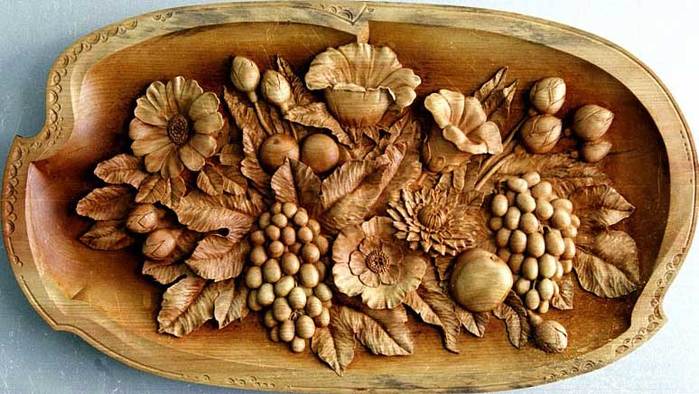
On various household items, one can see a nail-like thread, which was also applied with a special chisel in the form of a small semi-oval depression. Especially expressive is the nail-like carving on gingerbread boards, which were made by urban artisans. The production of gingerbread and gingerbread boards was widespread, but four centers were especially famous: Tver, Tula, Vyazma and Arkhangelsk. In the manufacture of all kinds of utensils - ladles, staples, bowls, valleys, ladles, saltcellars, the most common was the slotted technique. From birch, pine or spruce blanks, sometimes the basic shape was hollowed out of the rhizome, then the processing was completed with an ax and a knife. Large artels of craftsmen worked on the creation of dishes, peasants also participated in its production, filling this work with their free winter time... The making of tableware was specialized: some artisans made spoons, others made ladles, others were engaged in painting, etc. Tver, Moscow and Kaluga provinces, as well as the city of Kirillov, have been famous for their dishes for a long time. In the house carving of the Volga region, reliefs with a deaf and slotted background are widespread. The drawing they create has sharp, clearly legible edges. The plastic expressiveness is inherent in samples of the dampened (hardened) thread, the pattern of which was distinguished by smoothly rounded edges. In the Smolensk collection, candle boxes from the Vologda province are decorated with such carvings. The planks were covered with flat-relief carvings. Here, all parts of the pattern are in the plane of the board, and the background is taken out shallowly. In the 17th-18th centuries, planks were made of hard wood: birch, maple, walnut, pear, and in the 19th century metal parts began to be used.
According to some written sources that have survived to this day, we can judge the culture of the time when they were made. After all, the ancient Slavs, who inhabited the territory of the modern European part of Russia, were still engaged in the manufacture of these products. Since the manufacture of such items was mainly carried out by craftsmen, the tree acquired, as it were, a second life.
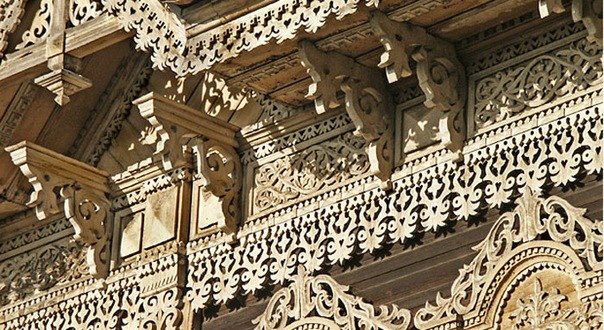
Wooden carvings were used to decorate pieces of furniture, dishes, toys and other products. Indeed, at the time, wood was a very popular material. Wood carving was widely used in wooden architecture of that time, giving us many monuments of architectural art. Wood craftsmen in Ancient Russia possessed great knowledge in this area of art, an excellent sense of beauty, rich imagination and a sense of beauty. All this allowed them to create real works of art both among wooden toys and among architectural structures.
Artifacts found in Novgorod during archaeological excavations are weighty evidence. Of particular interest is a fragment of a wooden column, which belongs to modern scientists to the 11th century AD. It is decorated along its entire length with a pattern that does not repeat along its entire length.
By the way, such patterns prove the fact that the development of creativity was even earlier than this period at a fairly high level among the inhabitants of that era. Already by those objects that were found much later than their use, modern scientists can judge the development of the culture of that time. It was they who brought in the missing part that helped modern historians to recreate the general picture of the life of that era.
Wooden decoration can also be judged by how wooden buildings were decorated four hundred years ago. This is reflected in numerous chronicles of those years. They vividly and vividly tell about the life of people who lived at that time, their way of life, both cultural and religious. These architectural monuments of that time and household items contributed a lot of information to the treasury of the history of our country.
Novgorod was an important center of carving art in Ancient Rus. The Novgorod school stood out for the consistency and clarity of the general compositional solution.
Some museums in Russia keep unique works - woodcarving. The earliest decorative images in folk art were ducks and horses. The State Hermitage has a scoop-spoon with a graceful handle in the shape of a bird's head (3rd century BC). Sculptural works were created (a wooden deer with branched horns on a proudly raised head dates back to the 5th-2nd centuries BC) and household items (buckets of Russian villages of the 10th-12th centuries with the image of a horse, duck, a sun disk). The tradition of the carved icon came to Russia from Byzantium, together with Christianity. The Hermitage contains samples of Byzantine carving: icons, crosses. By Orthodox canon it turned out that the carved image of the icon is usually in relief (in contrast to Catholicism, which preferred sculpture).
At first, a small number of Russian icon painters, an abundance of carving material, the tradition of Slavic carving contributed to the spread of carved icons in Russia. It was the faces of God carved from wood that were revered. The Church of the Deposition of the Robe in Moscow contains icons of saints and carved wooden gravestones of Moscow metropolitans. The most time-consuming and painstaking type of carving is presented there - carved miniature. Miniature wood carving is still not often found among carvers. The carving of items 3-6 cm in size is rare nowadays.
There are many mysterious pages in the rich history of Russian icon painting. One of them can be considered the tradition of the so-called. "Measured" or "dear" icons. Little is known about dimensional icons. The main data boil down to the fact that in Russia, on the day of the baptism of a newborn, they ordered an image "to the extent" of his growth. An icon of the saint in whose honor the child was named was written on a fairly long and narrow board, and subsequently she accompanied the person all his life.
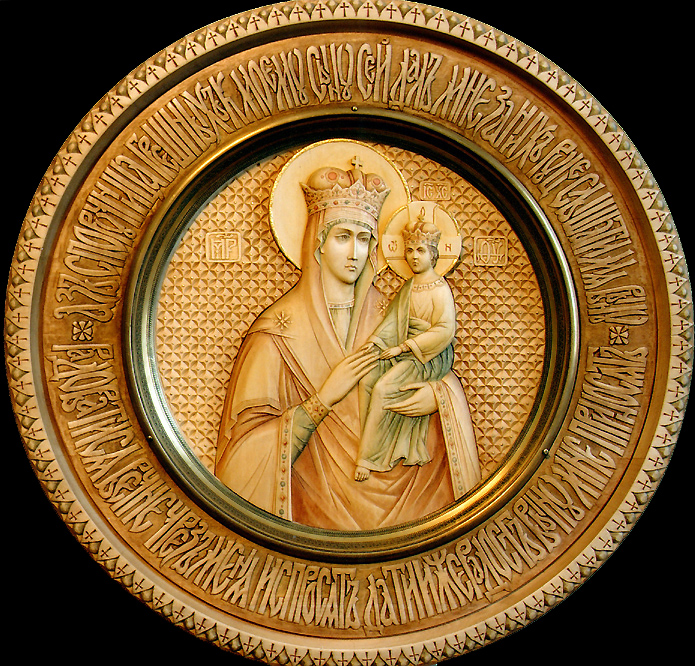
An Orthodox person turns to a nominal, measured icon when he needs protection and support. And probably there is no more important and necessary gift for a newborn baby than his personal, personal icon of his patron saint, presented to him during Baptism.
The images of the heavenly patrons of the newborn will be located in the space that corresponded to the body of the newborn, as if within its boundaries. Parents thereby establish a special, personal, unbreakable bond between the icon and the newborn. The connection is perhaps stronger than that which arises when buying a personalized icon or receiving it as a gift. Icons depicting the namesake saints can come to a person throughout his life in different ways and in different time how many such icons a person will have depends only on the will of God. The measured icon is one. The measured icon belongs to only one person from birth to death, and is associated with only one person, even if for some reason the owner loses it. It can belong to another person legally, but it will never become HIS icon, since the spiritual, higher connection between the measured icon and the child is established forever. As a rule, a measured icon is closely connected with the sacrament of baptism, with those people who give the icon to a newborn, with their love and good feelings. A measured icon can be obtained at any age, depending on when the sacrament of baptism was performed, shortly after birth or later. When ordering a measured icon for a child, people close to him actually create it themselves, since they can take a direct part in defining the plot of the measured icon. What is the traditional iconography of dimensional icons?
The plot of the icon, the choice of the patron saints of the newborn is determined by the dates of birth and baptism of the child. The most laconic plot of a measured icon is the image of a saint, whose name is given to a child at baptism. Perhaps, along with the saint, whose name was given to the newborn at baptism, there is a simultaneous image of the saints, on the day of the celebration of which the child was born. If the birthday or baptism of a child coincides with the day of celebration of some revered icon (for example, the revered image of the Mother of God), then the image of the Virgin may be depicted in the center of the icon, and images of saints whose names are associated with birthdays and baptisms were placed on the margins of the measured icon. ... In any of the considered variants of iconography, an image of a guardian angel could also be present.
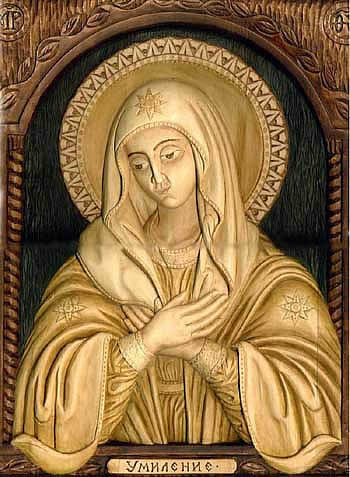
When referring to historical sources, it is revealed that on the "dear" image, in addition to the heavenly patron of the infant, the Holy Trinity could also be written, overshadowing and blessing His saint. Such, for example, are the measured icons kept in the Archangel Cathedral of the Moscow Kremlin: “St. John Climacus "," St. Theodore Stratilat "and" St. Dimitri of Thessaloniki ”(it is assumed that they belonged to the three sons of Ivan the Terrible - respectively, Ivan, Fedor and the murdered Tsarevich Dmitry of Uglich). And in the 17th century, the famous icon painter Simon Ushakov wrote to Tsar Alexei Mikhailovich in his petition: “... last year, Sovereign, according to your Great Sovereign's decree, I, your servant, the measure of the Blessed Tsarevich and Grand Duke Peter Alekseevich ... Trinity and St. ap. Peter was famous ... "(that is, he finally wrote down the main details and faces on the icon). It is not hard to guess that the “measure” - the measured icon in question - was created for the future Emperor Peter the Great.
For the ancient Russian person, the invisible, spiritual unity between the infant and the icon intended for him finds its embodiment in the size of the image. The measured icon, as it were, consolidated the identity of a person with the sacred world, with his heavenly patron.
The baptism of an infant is preceded by a ritual of giving a name. From this moment, according to Orthodox views, a person's life turns into a march towards earthly temple where salvation is to be done. The name of a person carries a deep spiritual meaning, distinguishes him from many other people, asserts the uniqueness of his personality, for our Lord Jesus Christ was crucified for him too. At all times the name Orthodox person was considered a saint, therefore, from the very childhood, a Christian was taught to respect his name, therefore, the tradition was born to call the person to be baptized in the same way as one of the saints, who became the heavenly patron and intercessor. Thus, the idea of merging (even “in the flesh”) of a newborn with the holy name given to him can find its visible embodiment in the creation of an icon in proportion to the growth of the baby.
Subsequently, the measured icon was perceived precisely as a special relic and was closely connected with the entire fate of its owner, constantly accompanying him in life. Its further path after the death of the owner is not entirely clear. However, it is known that the "dear" images of representatives of the royal family, as a rule, acquired a permanent place in the iconostasis above the tomb. This is evidenced by the presence of several measured icons in the royal tomb - the Archangel Cathedral of the Kremlin, as well as in the churches of the Novodevichy Convent, where the Moscow princesses lived and died. Here are preserved dimensional images of numerous sisters of Peter I, including “St. Martyr Sophia "(belonged to the famous princess Sophia).
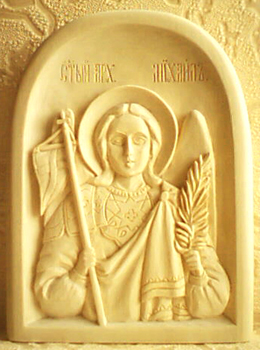
The purpose of the home icon is to show us the world of the invisible and tune in to the perception of invisible, spiritual things. The icon captures the connection between the little man and the saints, whose names are already written in heaven. It keeps the man on his life path Orthodox Christian.
Identity with the patron saint and the Church of Heaven, captured in a dimensional icon, returns us to spiritual sources. The icon itself is not a self-sufficient phenomenon, but an image, a likeness and a reminder of a higher reality that is not completely comprehensible to us, which is the task of every person living on earth not to forget and strive for.
In the XV century. the famous carver and jeweler Ambrose worked in the Trinity-Sergius Lavra. His woodcarving: carved crosses and icons were distinguished by complex multi-figured compositions, made very carefully from dense, dark wood walnut, valuable rosewood, cypress and boxwood. He sculpted from wood and bone and was the organizer of the school of carvers. By the 19th century, a significant number of icon carvers were working in Russia. In the XVI century. the Kremlin Armory began its activity, which had, among others, a workshop for carving and joinery. Here in 1551 was created one of the remarkable works of Russian art - the Tsar's chapel of Ivan the Terrible for the Assumption Cathedral of the Moscow Kremlin. The tent-roofed throne is completely covered with intricate carved ornamental and subject compositions. In the XVI century. wood carving its character changes slightly. Carving relief of the 16th century. higher, voluminous. An inexhaustible imagination and skill were displayed by folk carvers in the wooden decoration of numerous cathedrals and churches in Russia. One of the most striking monuments in the history of Russian carved art was the Kolomna wooden palace near Moscow. Architects S. Petrov and I. Mikhailov designed in the second half of the 17th century. for Tsar Alexei Mikhailovich, the palace, which eyewitnesses called the eighth wonder of the world. This palace stood for about a hundred years, glorifying the art of folk carvers.
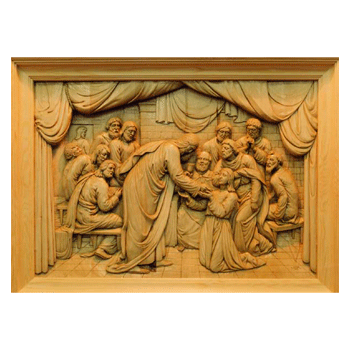
Artistic woodcarving during the construction of St. Petersburg and its environs, when craftsmen decorated new palaces, estates, churches and cathedrals with carvings. And now the wooden iconostasis of the Peter and Paul Cathedral, created by carvers I. Telega and T. Ivanov with assistants, arouses admiration. Andrei Konstantinovich Martov, who was in charge of the palace turning workshop under Peter I, was a magnificent woodcarver. The works of Russian carvers were in no way inferior to those of foreign masters. Wood carving is a national art form for many peoples of our country to this day. Over the centuries, the skill of artistic woodcarving has been passed down from generation to generation. Passing on the artistic skills of woodcarving, Russian craftsmen have kept the national traditions of original wooden plastics for centuries.
Ancient church wood carvings are admired to this day. Carved wooden Royal gates the Church of the Ascension of the city of Rostov Yaroslavsky, also bearing the local name of the Church of Isidore the Blessed, is an outstanding work of Russian plastic art of the 16th century. The original form of the gate and the exquisite craftsmanship of the carvers who created them give reason to consider the gate as one of the most important monuments of world art. Much attention has always been paid to them in the special literature, but only after their restoration, carried out in 1962-1964 by the restorers of the State Central Restoration Workshop named after Academician I.E. Grabar, did they manage to see the true character of the unusually delicate work. Woodcarving was discovered, which until then was under layers of gesso and repeated rough gilding. From skillful hands Rostov carvers, a thin, surprisingly graceful woodcarving appeared.
Time did not spare the ancient carvings, but wood carving, even poorly preserved, allows you to see what was laid in them by the creator. Sculptural wood carving was almost unknown until recently. And if the painting of Ancient Russia became the property of science at the beginning of the 20th century, then sculpture - only at the present time. Researchers have discovered a large number of previously unknown works of sculpture and decorative carving, and these discoveries have enriched the history of Russian art with interesting examples of folk art. An ancient wooden sculpture was discovered in different parts of Russia and decorative carving on wood. The intrinsic warmth and fragility of wood are akin to warmth and fragility human body... They evoke a feeling of extraordinary, incomparable, spiritual closeness and peace. The work of an icon carver requires strict discipline, a sense of the material, and perfection in work. It is impossible to make a mistake here - one wrong cut ruins all the previous work. Working with wood does not allow for haste and fuss.
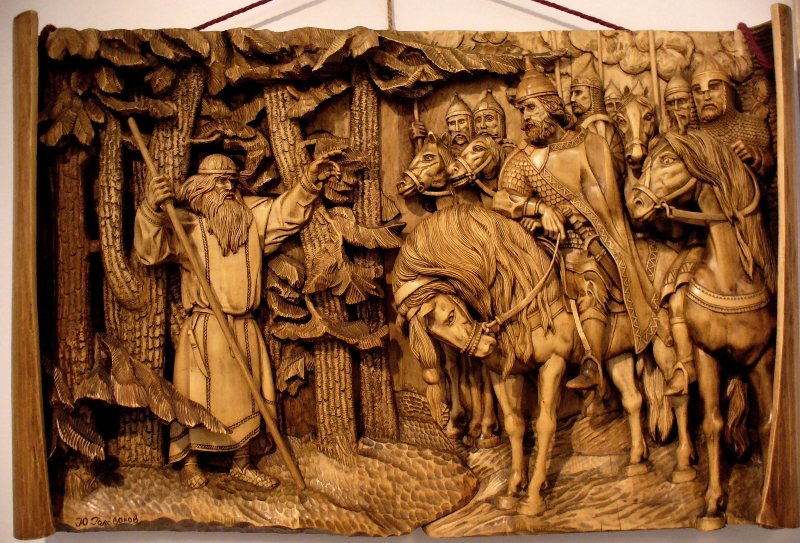
To make the work go smoothly and the carving of the ball is thin and precise, the author uses linden, the wood of which is one of the softest. Previously, in Russia, peeling linden logs were stacked under a canopy, where they were dried all summer. In the winter, when the peasant had a lot of free time, he would bring lutons to the house and begin to tinker. The village master cut toys, dishes and other household utensils from the logs blackened over the summer. Pure white wood was exposed under the chisel. Some peasants sent the finished products sparkling with whiteness to the bazaar. And perhaps, by the village craftsmen, whose occupation was woodcarving and invented the once prevailing riddle: "In the hut - with a raven, out of the hut - with a white swan." It wasn't that hard to figure it out. Of course, this is a lutoshka - a linden log - woodcarving by a skilled carver.
When looking at chiseled or carved linden products, we hardly notice its texture. It seems that they are made of a homogeneous pulp, devoid of lamination. This idea is formed because no matter how sharp the cutter is, it still crumples wood fibers, making the wood slightly velvety in cross sections and glossy in longitudinal sections, so it seems that linden does not have any specific texture pattern. Linden wood is soft, especially steamed, but when dry, it becomes quite hard. Therefore, linden carving was especially widespread: craftsmen carved various tableware: ladles, ladles, broths, bowls and spoons. Bowls, dishes and turning toys were sharpened on lathes, among which were the famous nesting dolls. Carvers made from rich linden carved furniture... Linden wood smells peculiar, this smell is resistant and persists for many years. In some regions, peasants believe that a light honey spirit always lingers in a bathhouse cut from linden ridges, because damp wood smells even stronger.
Linden is not only well cut, but also bends and polishes well. Linden was also used for the manufacture of wooden parts of accordions. Veliky Ustyug craftsmen carved the finest birch bark patterns on a lime cutting board. And the Bogorodsky carver was doing rough processing of the linden blanks with an ax on a linden block. And this is no coincidence - after all, on soft and viscous linden wood, tools are less blunt.
Oil, caviar and grape juice are well preserved in linden containers. In the Caucasus, huge vats were hollowed out of linden to squeeze out grape juice and churns were made. In modern cooperage production, linden rivets are used to make dishes for storing and transporting granular caviar.
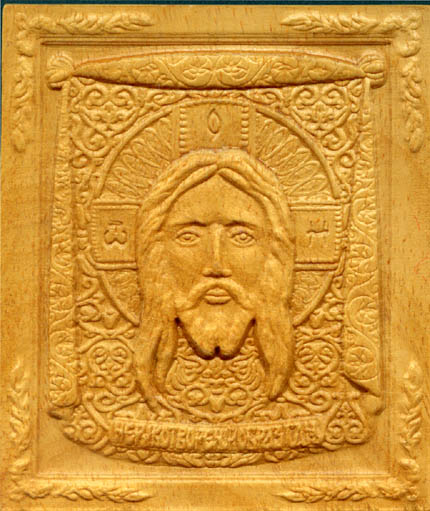
Craftsmen carve special wooden parts from linden hand tools... The engravers of the village of Kubachi make the handles of shtikhels from linden, and the wood-carvers of Bogorodsk make the handles of knives and chisels. The craftsmen explain this preference for linden by the fact that its soft wood is less filling the hand than hardwood. Many people try to use the wood of the old linden for these purposes, since it has more porous and friable wood. It is pleasant to work with a linden tree, and the condition of the carver affects the entire course of the carving, therefore, the product from it turns out to be attractive.
Speaking about wooden plastics of Ancient Rus, it should be noted that numerous archival documents, as well as records of foreigners who visited Russia, indicate that woodcarving and wooden sculpture took place in the life of the Russian people and were valued by them.
Conclusion.
There is a belief that our home is alive, and the walls in it retain all the information.
The house can spoil the life of the owners, or it can be a kind helper. Sometimes at home we do not have enough feeling of warmth, comfort, some kind of discomfort appears. Our mood and spiritual comfort depend on the cosiness in the house. A house is not just walls and a roof over your head, and its energy depends on many factors. It is not so difficult to turn native walls into a home, which shelter not only from bad weather, but save from anxiety, irritation, fatigue. Not only comfortable furniture, but also furnishings, their shape, materials from which the things around us are made, create a unique atmosphere at home, affect our psyche.
The walls soak up our thoughts and feelings. Items pleasing to the eye, filling the house with light, help to maintain a good atmosphere in it, protect against strong feelings... It is better to find out the relationship on the street in order to save the house from the energies of irritability and resentment. The house must be protected not only from our own negative radiation - it must be closed to people who are casual or unpleasant. The house is not a courtyard, this is our last fortress. It is not for nothing that our ancestors carved a dove over the porch with outstretched wings, urging those entering the house to have pure thoughts.
Since the most ancient times, it has been known about the ability of a tree to get rid of accumulated negative energy. Wooden gifts radiate warmth. Wooden souvenirs will bring harmony and comfort to your home. Wood carving also requires special qualities of character: perseverance, patience, and diligence are important here. It is very important to make the right cut so that the properties that nature, as the creator of a tree, endowed it with are fully revealed. But all this is not enough. A truly harmonious product appears only when peace reigns in the author's soul. It is the work done with warmth that will help you see the beauty of the tree.
Bibliography:
1. B.A. Rybakov Paganism of ancient Russia M., Science, 1988
2. Encyclopedic Dictionary Slavic mythology M., Ellis Pak 1995
3. A.V. Opolovnikov, E.A. Opolovnikova Wood and Harmony M., 1998
4. NN Sobolev Russian folk woodcarving M., 2000
5. Russian hut Illustrated encyclopedia of St. Petersburg 1999
A common type of Russian. the architectural carving was flat carving. It is also called crenate, grooved, notched, trihedral-notched. All kinds of geometric patterns were cut out with an ax and a chisel on thick, hand-chipped boards, and the background and bulge on them are not opposed to each other. Ancient flat wood carving has had a definite impact on stone carving. Many plots of flat carving are associated with the ancient pagan beliefs of the Slavs and their magic spells. Such widespread motifs in folk patterns as circles, rosettes, stars, cruciform signs, as well as squares and rhombuses, served in ancient times as symbols of fire and sun and were supposed to protect the home. If in the Stone Age and Eneolithic Birds, animals, the sun, etc. were realistically depicted, then by the 2nd millennium BC. they already turn into symbolic figures: birds (ducks) - into zigzags, the sun with rays - into a circle, a wheel, etc. These have already become approx. 4 thousand years ago, symbolic images of birds, animals, the sun, etc. survived to this day in the decoration of houses. At least from the Neolithic to the present day, Rus. folk art and architecture brought to us images of pagan amulets and bereginas. In the Volga region, relief carving was widespread, which is often also called ship carving. Here, the rich pattern of the picture with high rounded edges already rises in relief above the background. The patterns were composed mainly of plant elements - from finger leaves, curls resembling antique acanthus, fruits, flowers, bunches of grapes, which were often complemented by images of fantastic creatures: sirens - half-women, half-fish, sirins - birds with a female head, lions, as well as classical motifs rosettes, medallions, squares, etc. Intricate carving with a raised relief and bizarre patterns of interweaving of grasses, animals and birds was already known in Ancient Russia. The rich carving of stone Vladimir churches of the 12th - 13th centuries, in all likelihood, reflected the techniques of wood carving that were common at that time. Columns of the 11th century are known. with relief carvings from Novgorod. In the XV - XVI centuries. such a carving was called Fryazhskaya, in the 17th century. carving with a high relief is called figured or flem, the masters of the Moscow Armory were especially famous for it. In the second half of the XIX century. in Russian In villages, flat and relief carving began to disappear everywhere, being replaced by saw-cut carving. With such a thread, the pattern is applied to the surface of the board not by gouging, but is sawn through with a jigsaw in a thin board, and then stuffed onto platbands, frontal boards, etc. Embossed and flat carvings are retained only as a finish and to complement jigsaw patterns. At first, sawn patterns were fairly simple, but by the end of the 19th century. complex compositions with plant and zoomorphic motifs are made from simple geometric shapes. Despite the simplification of the carving process, the cost of decoration sometimes amounted to a quarter of the value of the house, although usually the average peasant decorated the house only with carved platbands and a modest pattern along the pediment or cornice. In Russian. coloring was also widely used in wooden architecture. US. it was used to decorate pediments, filing of roof overhangs, mezzanines, balconies, and shutters of platbands. In the Volga region, mainly window shutters, pediments and gates were painted. Drawings, simple in execution, were made in an extremely bright range of colors - blue, red, green, white and yellow. Usually carved decorations were painted, and often the entire building as a whole. This kept it from rotting. The coloring of architectural details never violates the structural plastic of a building, but only emphasizes its expressiveness.
Watch value Wood Carving In Old Russian Architecture in other dictionaries
Thread- cuts (thread, threads - obsolete), pl. no, well. 1. Carving, dressing of various patterns on wood, bones. Specialist in artistic carving... 2. A patterned pattern cut on ........
Ushakov's Explanatory Dictionary
Thread- -ы́; f.
1. to Cut (6 characters). Get carried away with stone carving. Artistic R. Old carved frame.
2. Drawing, pattern, carved on wood, bone, stone, etc. Casket with thread .........
Explanatory dictionary Kuznetsov
Bogorodskaya Carving — folk craft toys and sculptures made of wood (probably from the 16th-17th centuries) in the village. Bogorodskoe, now Sergiev-Posadsky district, Moscow region. From the detailed figures ........
- All-Russian Scientific Research (VNIIIS) - organized in 1980 in Moscow on the basis of the Central Institute for Scientific Information on Construction and Architecture. Research ........
Big encyclopedic Dictionary
Mezen Wood Painting- the type of painting of wooden spinning wheels and utensils - ladles, boxes, brothers, which took shape by the beginning of the 19th century. in the lower reaches of the Mezen river. The oldest dated spinning wheel with a Mezen painting ........
Big encyclopedic dictionary
Thread- in technology - alternating protrusions and depressions on the surface of the body, located along a helical line. There are triangular, rectangular, trapezoidal threads, ........
Big encyclopedic dictionary
Stone carving- (a. Stone carving; n. Steinmetzerei; f. Taille de la pierre; and. Tallado en piedra, grabado en piedra) - the process of giving the stone the required shape and external. finishing by sawing, turning, drilling, ........
Mining encyclopedia
Proceedings of the Department of Old Russian Literature- (TODRL) - non-periodic. edition of the Institute of Rus. Literature of the Academy of Sciences of the USSR, carried out since 1934. By 1973, 27 volumes were published. (M.-L.). TODRL editors at different times were acad. A.S. Orlov, Corresponding Member AN ........
Soviet Historical Encyclopedia
Blind thread- End-to-end carving made in solid wood, designed for the perception of relief when sunlight or special lighting.
Construction vocabulary
Sawing. Cutting Thread- Openwork through woodcarving made with a special saw. Platbands, cornices, quilts, etc. in wooden architecture are made by sawing.
Construction vocabulary
Thread- thread
formed on the surface of the part, alternating spiral (helical) grooves and projections of constant cross-section (cutting). Threaded parts can form ........
Encyclopedia of technology
THREAD- THREAD, -y, well. 1. see cut- 2. Pattern cut on hard material. Patterned r. Casket with carving. 3. Spiral screw thread. || adj. threaded, th, th (to 3 meanings; special). Threaded fastening.
Ozhegov's Explanatory Dictionary
Blind thread- performed with a chisel or chisel in the mass of the board without the penetration of the tool through; designed for the perception of relief in sunlight; distributed ........
Architectural vocabulary
Overhead thread- A carved wooden decoration that does not form a single piece with the adjacent background. (Terms of Russian architectural heritage. Pluzhnikov V.I., 1995)
Architectural vocabulary
Cutting thread- Pattern on wooden board(1) or plywood made by a through-cut and intended for transmission through. (Terms of Russian architectural heritage. Pluzhnikov V.I., 1995)
Architectural vocabulary
Then she wore mostly a cult character. In the patterns of ancient ornaments, one can distinguish the sun, rain, people raising their hands to the sky, geometric shapes (circles, triangles, rhombuses) and other signs designed to provide protection from the elements and the fertility of the earth, as well as serving as a talisman for dwellings.
Of course, even then the religious meaning wooden drawings was combined with a purely utilitarian purpose of various elements: platbands are designed to protect from cold and moisture the cracks between the window frames and the log wall of the house, the moorings are the ends under the roofing slats, etc. the practical meaning has been preserved, and the cult has gradually been lost. Only tradition decoration the facade remained. Over time, each locality developed its own style of carved decorations, and the patterns of the platbands of different regions could differ significantly. Wood carved decor is distinguished by a variety of techniques, subjects and compositional arrangement on the house.
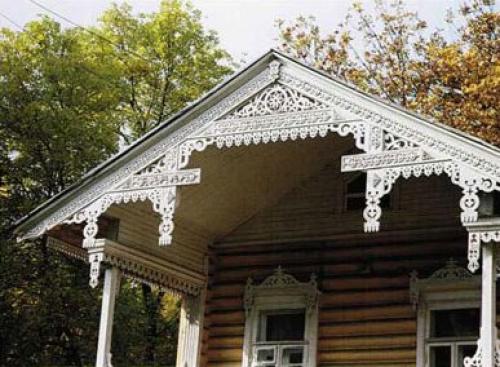
In some regions, they preferred to use sculptural carving, in others - deaf, in the third - slotted. The most widespread was and remains precisely slotted (also called sawing and openwork) carving, although it arose later than others.
![]()
Tradition and innovation.
The main motifs of wooden carving have changed little: geometric and floral ornaments are still popular, zoomorphic (depicting animals) and anthropomorphic (depicting people) are less common.
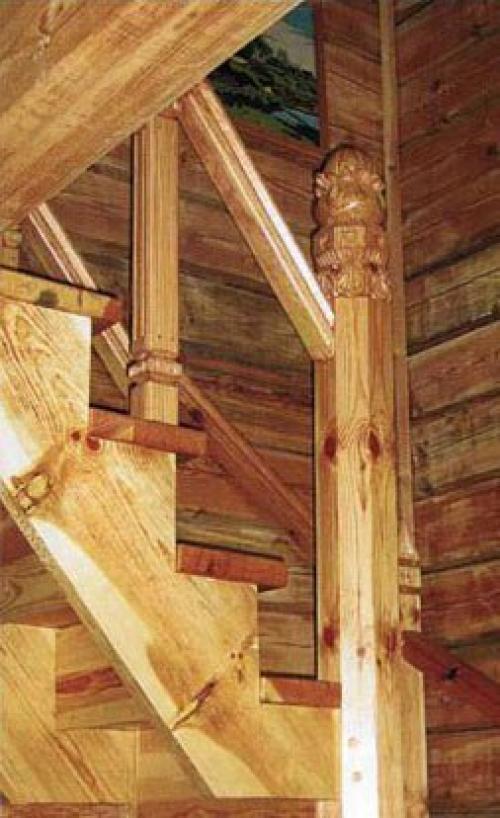
In a house, especially a wooden one, carving is found not only outside, but also inside (for example, in the design of stair balusters and fences, furniture and doors, sculptural or embossed carving is usually used.
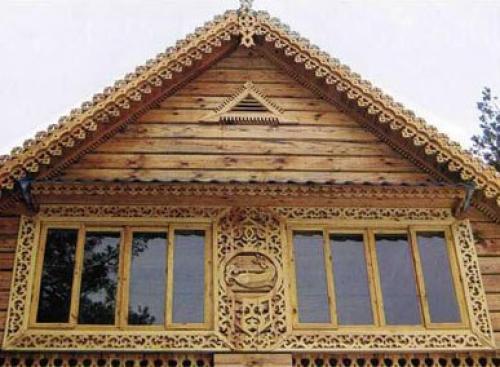
The following types of Russian architectural carving can be distinguished: sculptural, flat, relief and slotted (its variety is overhead carving. Probably the most ancient species- flat wood carving, including a number of varieties - notched, slotted, grooved, etc. The most common motif of flat carving is geometric. On balconies, porches, upper platbands of windows and doors of many old wooden houses cut out a circle with diverging rays. Of course, this symbolic image of the sun goes back to pagan ideas about the world. Other geometric shapes characteristic of flat carving are probably associated with ancient magic spells - circles, crosses, stars, rhombuses, etc.
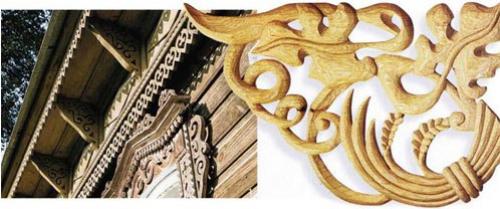
Sculptural carving is most typical for the northern regions of Russia. The outlines of animals and birds, both real and mythological, were given to the protruding ends of the logs and beds. But the most widespread was the decor of the cooler on the gable roofs of Russian huts. The oglupnya was most often given the shape of a horse's head, which originally had a sacred meaning. They also performed images of other animals and birds - deer, goose, swan, etc.
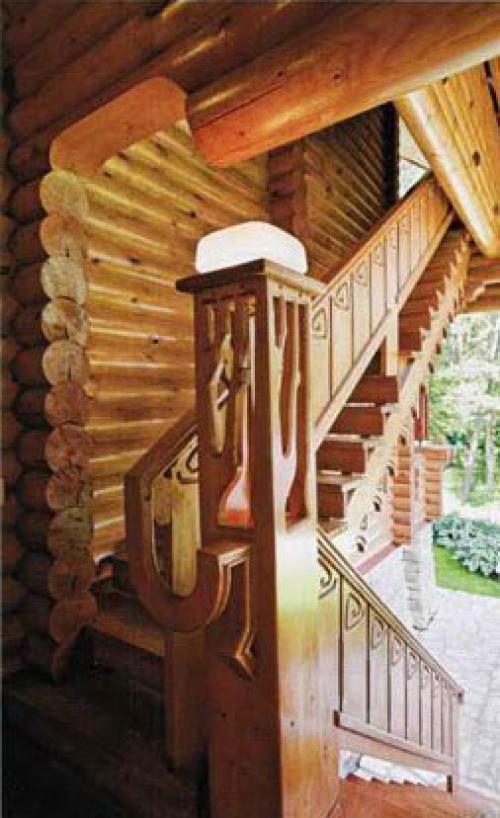
Today, sculptural images on the ridge of rooftops are rarely made, although such services are offered by craftsmen and even firms. In addition to the butt-ends of the logs and the hulp, the shutters and platbands of houses in some Russian provinces were sometimes decorated with sculptural images of various animals and birds.
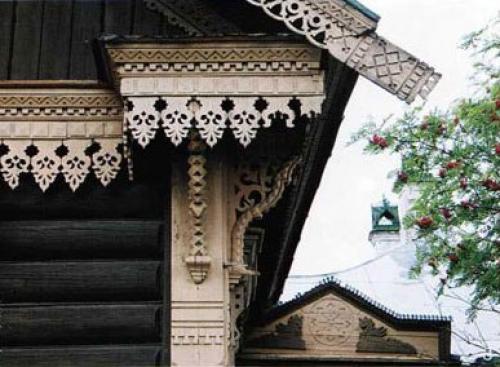
Relief carving was most widespread in the Volga region. It is also called a chisel because the main tool for its execution (in addition to an ax) is a chisel. This type of carving is characterized by a high bizarre relief. The most common ornament is floral, but images of various animals and mythological creatures (lions, mermaids, sirens) are also often found.
One of the most striking examples embossed carving considered the wooden palace of Tsar Alexei Mikhailovich in Kolomenskoye, built in 1667-1672. and disassembled at the time of Catherine II. Literally everything in it was decorated with the finest carvings - friezes, valances, porches, galleries. However, soon we will have the opportunity to admire the extraordinary decor - the restoration of the palace should be completed this year.
The simplest, and therefore the most common type of house carving is through (also called slot, saw, openwork. It is performed by through cutting of planks from 5 to 50 mm thick. It differs from other types of wood carving in that the background is completely removed However, its popularity is explained not only by the relative ease of execution. openwork drawing with through holes casts a lace shadow, and the angle of illumination, which varies during the day, changes the shadow pattern and appearance of the facade of the building depending on the weather. Moreover, slotted thread can be multi-tiered, that is, carved boards of hairstyles and Podzorov are superimposed on each other. Then the feeling of airiness of wooden lace is intensified many times over.
Inner world.
The carved decor is by no means limited to the facade, especially when it comes to wooden house... Wooden carved decoration is ideal for its walls. Balustrades wooden stairs(and above all turntables) are traditionally decorated with carvings, which can be both very simple and extremely complex - carved ornament able to imitate almost any style and any era.
Not only balusters and railings are carved, but also structural elements stairs - steps, bowstrings, stringers, platforms.
In most of the firms engaged in the manufacture of carved wooden stairs, you can also order individual carved interior items - a frame for a mirror, furniture, candlesticks and much more.
When ordering a staircase, the client has the opportunity to offer his own drawing or use the services of a specialist. You can make almost invisible patterns covering the stairs with the finest exquisite mesh, or, conversely, create a bright accent. In any case, the design of the stairs will be original, hand-made according to an individual order.
With the help of carved stairs, furniture, doors, other functional and decorative elements it will be possible to recreate almost any interior style, with the exception of high-tech and Japanese minimalism. For example, modern art nouveau, which is popular today, is characterized by bizarre floral ornaments, elegant wavy lines, therefore wood carving- one of better ways imitations of this style... Rococo is characterized by sophistication, an abundance of decorative elements, wavy floral ornament, the use of mythological or erotic subjects. Rich decor, solemnity and pretentiousness of the baroque - everything can be conveyed with the help of carving.
Towel - a vertical carved board on the pediment or on the sides of the platbands.
A valance is a carved board or a row of short vertical carved boards bordering the roof overhangs in the form of solid lace.
Frieze - horizontal stripe ornament running along the edge of the house.
Wings, or moorings, are two boards decorated with carvings on the pediment, covering the ends of the under-roof slabs from moisture. The brush is the lower hanging part of the berth, the platband is the decorative frame of the window or doorway. Often wooden platbands are decorated with carvings.
For house carving, sketches with small details should not be chosen. Otherwise, the carved products will not last so long, and small elements will be lost against the background of the facade. By the way, house carving looks good even from a distance.
The overhead thread is a type of slotted thread. During its implementation, individual carved elements are glued or nailed to the board, forming a solid background. The protruding carved elements are often painted in contrasting colors.
Okhlupen (in the old days) - a log with a gutter, crowning the roof and covering the upper junction of its slopes. The ridge is the upper horizontal edge of the joint of the roof slopes. In the old days - the butt part of the oglupnya in the form of a carved horse head above the facade of the house.
Carving is suitable not only for houses in the traditional Russian style, for example, a fancy carved ornament of window and door frames with plant motifs - grape brushes, leaves, etc. can serve as a decoration of a mansion in the Art Nouveau style. In such cases, relief carving is often used.
Read more information about the interior of wooden houses











Energy drinks: give vigor, but take away health What will happen if you drink 4 energy drinks
Mustard for weight loss: how to use the seasoning with maximum benefit Is it possible for children to have mustard
The benefits and harms of mustard for the human body Table mustard benefits and harms
How to treat the ear after piercing: types of antiseptics, their composition, rules and features of the treatment of a pierced ear
Sistine Chapel in the Vatican: description, history, architectural features